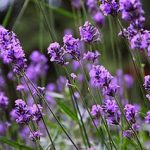
Lavender
Lavandula angustifolia is the lavender with which people are most familiar. However, there are over 200 varieties of lavender in the world. Most of these are not used in aromatherapy though.
These are three lavenders you might find in an aromatherapy office:
- Lavender
- Spike Lavender
- Lavandin
To make it even more confusing, within these main varieties there are several chemotypes. What is a chemotype? Think of it as chemistry type. Climate, location, light, soil, and temperature all affect the chemistry of any plant on our planet. This matters because one chemotype of lavender grown in Corsica may have more of one compound than another type grown in California. Knowing the origin gives you information about particular uses for these chemotypes. There are varieties of chemotypes of many different herbs, but the most familiar ones are varieties of eucalyptus, rosemary, and chamomile. For now, we will only discuss the three lavenders and their personalities, and why one more than another might be useful to you on your life journey.
Lavandula angustifolia, “Lavender” is native to the Mediterranean, although lavender is grown in many parts of the world today. Distilling the leaves, stems and flowers give lavender its signature camphor and sweetness in aroma.
Lavandula latifolia syn. spika, “Spike Lavender” is one beautiful and hardy Lavender, with long greyish-green leaves and tall spikes with flowers. You can easily find this variety in the Mediterranean, Spain, Italy, and France, as well as other places around the globe. Spike Lavender has a sharper aroma than regular lavender, rich with woody notes.
Lavandula x intermedia, “Lavandin” is a hybrid between true Lavender and Spike Lavender. How clever! One of my personal favorite oils, it is one smart lavender, with traits and capabilities of both lavenders combined. This plant is a tough variety and does well in scrubby areas and hot climates. The flowers on Lavandin can be white or purple, although most are purple. It produces a very high yield, due its tall stature and large flowers. The aroma is bright, strong, sweet and stimulating.
Sources: Harding, J. (2010). The Essential Oils Handbook, New York, NY: Sterling Publishing Co., Inc. pp. 106-107, 134-135; Schnaubelt, K., PhD (2011). The Healing Intelligence of Essential Oils. Rochester, VT: Healing Arts Press. pp.125,168; Haas, M. (2004). Quick Reference Guide for 114 Important Essential Oils, San Rafael, CA: Terra Linda Scent and Image. pp. 61, 62
Articles copyright of Rebecca Mitchell-Guthrie and not to be reprinted without permission.
The information presented on this site is not intended to diagnose health problems or to take the place of professional medical care. The information contained therein is neither intended to dictate what constitutes reasonable, appropriate, or best care for any given health issue, nor is it intended to be used as a substitute for the independent judgment of a physician for any given health issue. All content, including text, graphics, images and information, contained on or available through my web site is for general information purposes only.
Image: photo by Riley Huntley / CC-BY-SA 3.0
